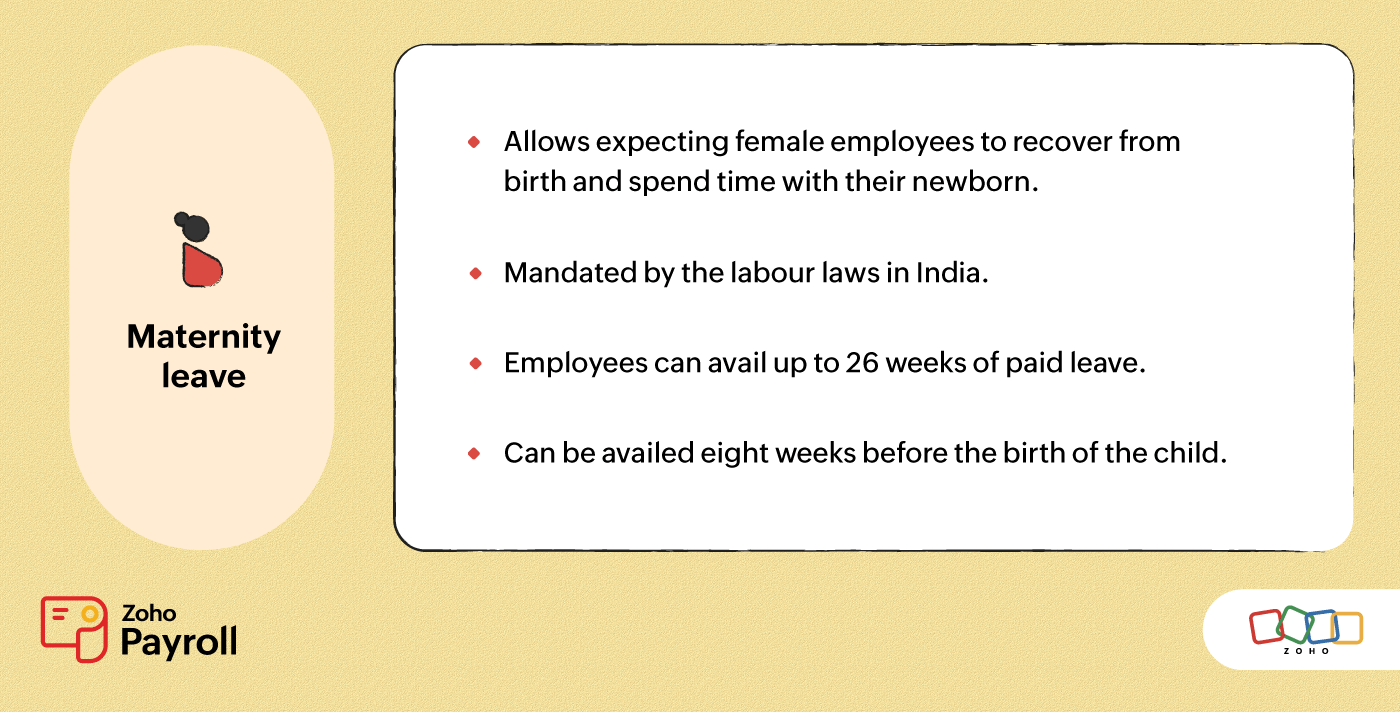- HOME
- HR and payroll
- Maternity leave rules in India: Meaning, policy, and eligibility
Maternity leave rules in India: Meaning, policy, and eligibility
Maternity leave is a benefit provided to support working women during pregnancy. In India, the labour law requires employers to offer paid leave to expecting mothers, ensuring they can prioritize their health and well-being. In this article, we’ll learn the meaning of maternity leave, eligibility criteria, leave duration, and how to create a maternity leave policy for your organization.
Introduction to maternity leave in India
Maternity leave is a type of leave provided to female employees who are pregnant. This leave also extends to mothers who adopt a child, ensuring they bond with their infant.
The primary purpose of maternity leave is to ensure the health and well-being of women employees. In India, this leave is governed by the Maternity Benefit Act, 1961 (amended in 2017), which applies to all employees across both private and government sectors.
Employers must provide maternity leave to eligible female employees in compliance with this act. The act specifies the eligibility criteria and duration of the leave, which are discussed in the following section.
Understanding the Maternity Benefit Act
The Maternity Benefit Act is an important labour law that protects the rights and well-being of women during pregnancy and childbirth. It ensures that women are entitled to a period of paid leave, allowing them to care for their newborn without the stress of financial instability.
Applicability of the Maternity Benefit Act
The act applies to every organisation with 10 or more employees, excluding those who are covered by the Employees' State Insurance Act.
It includes factories, mines and plantation businesses, besides product and service-providing companies. Pregnant or adopting female employees who have worked in these establishments for at least 80 days in the preceding 12 months become eligible for this leave.
Duration of maternity leave
The duration of maternity leave varies depending on circumstances such as the number of children, adoption, surrogacy, and cases of miscarriage.
- First and second child pregnancy: Initially, the Maternity Benefit Act of 1961 mandated a leave period of 12 weeks (84 days) for pregnant employees. However, the amended Maternity Benefit Act of 2017 extended this duration to 26 weeks (182 days).
- Subsequent pregnancies: For the third and subsequent children, employers are required to provide 12 weeks of maternity leave.
- Surrogacy: Biological mothers who use their egg to have a child via a surrogate mother are entitled to 26 weeks (182 days) of maternity leave.
- Adoption: Women who legally adopt an infant under three months old are eligible for 12 weeks of maternity leave starting from the day the child is placed in their care.
- Miscarriage: In the event of a miscarriage or medical termination of pregnancy, the employee is entitled to six weeks of leave from the day the miscarriage occurs.
When can maternity leave be availed?
- Pregnant employees can choose to take up to 8 weeks of maternity leave before childbirth and 18 weeks after, or the full 26 weeks after childbirth.
- Adopting and commissioning mothers are eligible for 12 weeks of leave from the date of adoption.
- In cases of miscarriage or medical termination of pregnancy, 6 weeks of leave can be taken from the day of the event.
Maternity leave salary rules
Female employees are entitled to their full CTC during the maternity leave period. This includes the entire basic salary as well as any allowances the employee is eligible to receive. The salary is typically calculated based on the employee’s actual salary from the three months prior to her leave request.
Medical bonus
Many employers offer medical bonuses to female employees during maternity leave as an additional benefit. While not mandated by law, these bonuses are allowed under the act and reflect the employer’s commitment to the well-being and protection of their female employees.
Work-from-home facility
The amended act includes provisions for work-from-home facilities for employees during pregnancy. If the nature of a woman’s work allows for remote work, the employer may permit her to work from home after her maternity leave, based on mutually agreed terms.
Access to creche facilities
Under the Maternity Benefit Act 2017, organisations with 50 or more employees must provide childcare centres or creche facilities near the workplace. Female employees must also be allowed to visit the creche up to four times a day.
Termination rules during maternity
An employee cannot be terminated during her maternity leave or any paid or unpaid leave related to childbirth.
Terminating a female employee during this period is considered unlawful, and she is entitled to legal remedies.
Additionally, after returning from maternity leave, her employment cannot be terminated without proper notice and valid reasons as mentioned in her employment contract or job offer letter.
Maternity leave extension
The standard maternity leave duration for the first and second pregnancies is 26 weeks. However, if the employee encounters difficulties in returning to work, the leave can often be extended based on a mutual agreement between the employer and the employee.
A quick summary

Frequently asked questions on maternity leave
Is maternity leave paid in India?
Yes, employees are entitled to receive their full salary during maternity leave, ensuring both job and financial security.
How many weeks of maternity leave are available?
Female employees can avail 26 weeks of maternity leave for their first and second child. For subsequent pregnancies, they are eligible for 12 weeks of leave.
Under what circumstances can maternity leave be extended?
Maternity leave may be extended if an employee experiences health issues related to pregnancy or childbirth. Extensions are also considered in cases of premature birth or miscarriage.




